#009
Community empowerment
for a healthy aging society
Miki Akiyama
Japanese Color: MUSTARD-iro
#009
Miki Akiyama
Japanese Color: MUSTARD-iro
MOVIE

Associate Professor
Faculty of Environment and Information Studies
Japan is entering a super-aged society that has never experienced in human history. Over the course of a long human life, one may experience serious illnesses, impairment, or loss of a significant other. In order to overcome such tough experiences without losing one’s hopes or motivations to live one’s life, it may be necessary not only to connect with surrounding people, but also to reconstruct the notion and perceptions of “health” and “happiness” sometime in one’s life course.
Associate Professor Miki Akiyama seeks to empower citizens in the community through providing places to learn and communicate about health and well-being. Through public health communication activities, she promotes citizens’ active participation in their own lives and communities.
The proportion of the elderly exceeded 25% in Japan, which is the highest in the world. It has been argued that we need to redefine “health” and “well-being” in such an aged society. Currently, I am engaged in designing communication for community development to achieve health and well-being of people.
The concept of “well-being” encompasses the idea of “living healthily and happily.” The approach toward achieving well-being does not remain at the micro-level of creating physical and mental health for individuals, but also extends to the meso-level of interpersonal connections, social participation, and developing local communities, and further beyond, to the macro-level that encompasses the formulation of local government policies and national policies.
Our research projects aim to promote self-support, peer-support, and social participation of various people including patients and the handicapped. Our goal is “empowerment”, which is about peoples and communities increasing control over their lives and their health. We are trying to empower people within their community through providing appropriate information and good communication.
Our core discipline is health communication, which is “the study and use of communication strategies to inform and influence individual and community decisions that enhance health”. Health communication take place in several layers and occasions — within a single person, between two or more people or within groups, between media and people, and between policy-makers and citizens. Designing and developing good health communication cultivates trust among the respective entities, improves the quality of care, and promotes social participation of citizens.
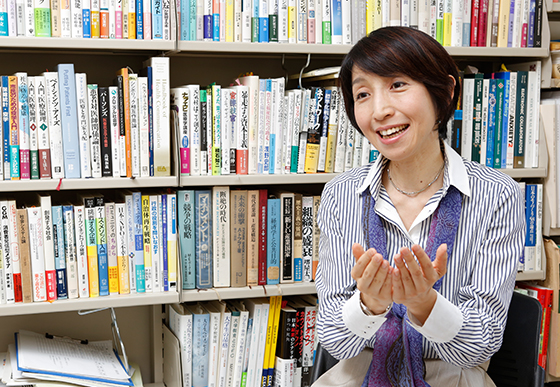
In a super-aged society, previous stereotyped ideas and notions become increasingly irrelevant. i.e. the notion that the elderly are the parties just to be supported and cared, or the idea of dichotomous division of “provider” and “beneficiary” that has formed the premise for health and welfare systems to date.
Nowadays, each citizen increasingly plays an important role to support their community welfare. Collaboration among local government, medical and nursing care providers, various community-based organizations such as NPOs, and community dwellers are more important than ever. I believe that the first step necessary is to pay attention to and to have careful consideration and good understanding of others in the region.
In order to promote healthy aging and livelihood in a community, we need to understand and make full use of human and organizational resources within the community. In rural areas, neighborhood relationship remains strong and geographically-based communities such as a local residential association are still very active today. On the other hand, in the cities, purpose-based communities such as NPOs are more frequently formed than rural areas. The healthy aging community development becomes effective through organizing such communities and interpersonal connections that are nurtured in the context of the respective communities.
It is noteworthy that even within the same local community, interests of people and the effective way to communicate with people may differ among different population (i.e. gender and/or generation). We put lots of creative effort in order to elaborate method to deliver messages or to interact with target audience. For example, on occasion of health seminar in rural area, we create and play theatre stage of the topic and issue we want to deliver as to make communication effective.
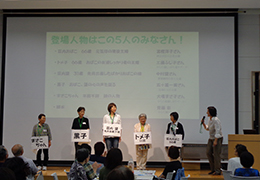
In order to solve complex problems surrounding healthcare nowadays, I strongly think “science” (i.e. medicine and epidemiology), and “art” that inspires and moves one’s heart are both important.
My research methodology combines epidemiology, social science, and social action. Epidemiology is the study of how disease is distributed in populations and the factors that influence or determine this distribution. With applying this study, we build a hypothesis and verify a causal relationship among factors associating health-related status or events in specified populations. Through this process, we gain understandings for setting policy priorities, and be able to formulate effective measures to promote health of the targeted population.
On the other hand, a separate approach is also needed especially in the implementation stage. In order to put preventive medicine or health promotion policy into practice, we need to motivate and induce people to change their perceptions and behavior (i.e. healthy diet and exercise).
People do not necessarily take action simply when accurate information is provided to them. Spontaneous motivation is also needed in order to bring about a behavioral change and ensure its continuity. We have to carefully determine the target population and choose the best media to reach the audience, to elaborate message resonant to the audience. Moreover, we often have to work on changing the surrounding environment and community contexts influencing health and well-being, such as schools,
neighbourhoods, and workplaces. Finally, we sometimes react to economic and social policy that influence one’s health-status and well-being. Such a comprehensive approach is called “ecological framework” which treats the interaction between factors at the different levels with equal importance to the influence of factors within a single level.
In my research activities, scientific evidence derived from medial and epidemiological researches and various theories of communication and behavioral studies are equally important. At the implementation stage, the fusion of various approaches may be described as the “fusion of science and art”.
In November 2007, we launched Karada-kan—Health Information Station in Tsuruoka Town Campus of Keio University (Tsuruoka City, Yamagata Prefecture). Karada-kan first started as a project to provide cancer information to the community dwellers but later expanded its scope of information provision to other life-style related diseases and health promotion in general. Since the launch of Karada-kan project, we have been providing a space in a community library to learn about diseases and prevention, various lectures and workshops on health-related issues, monthly peer support group meeting for cancer patients, and other networking opportunities. Every summer, Keio University students participate in projects of Karada-kan, in which they produce children’s workshops in order to get across the importance of life and health to elementary school students. We are also active in communicating research results obtained within the region in clear and simple language.
Karada-kan, positioned as a comprehensive information station of health, is currently putting effort into proactive learning among people in the local community, and into implementing activities aimed at strengthening social participation of citizens.
A specific example of these initiatives is Karada-kan Kenko-daigaku—the Interactive Health College. This initiative provides a mutual learning space where participating residents not only learn about health, but also to put into practice and continue with actions for improving health. This has been boldly named as “daigaku” (means “college” or “university”) as it incorporates the spirit of “learning while teaching, teaching while learning” propounded by the founder of Keio University, Yukichi Fukuzawa.
By removing a clear distinction between teachers and learners, and realizing a framework for mutual teaching and learning, Karada-kan Interactive Health College aims to circulate knowledge among local residents, to find talent and prospective leaders, and to improve their proactive participation in the community.
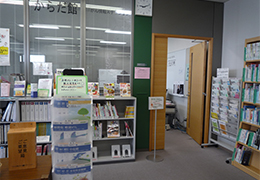
Health Information Station “Karada-kan” was established in 2007 in the Tsuruoka Town Campus as a collaborative project with the local community. We closely work with local medical institutions, the public health center, and other local governmental organizations to meet the needs of local residents.
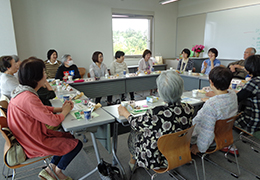
A monthly peer-support meeting for cancer patients has been held since the launch of “Karada-kan”. We have about 20 cancer patients coming every month, talking and sharing their experiences, and regaining their vigor for life.
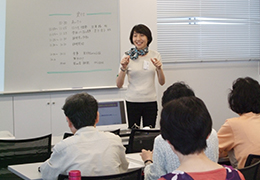
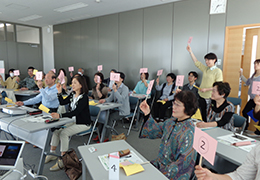
“Kenko-daigaku”, which means Health College, is a mutual proactive learning space for local residents. Based on the spirit of “learning while teaching, and teaching while learning” propounded by the founder of Keio University, Yukichi Fukuzawa, it aims to increase self-efficacy of participants and controls on their own health.
In an aged society, individual’s self-management of chronic condition, family care and community care for the elderly are increasingly important. To achieve well-being of people in a healthy aging society, each of us is likely to be required to play a greater participatory role in one’s own community.
In a global perspective, making a successful model of aging society in Japan as a top runner is of great importance for following aging countries and the rest of the world.
Information and communication are the essential components of “empowerment approaches” which have a positive impact on people’s health and well-being. Our task embraces not only producing good research evidence, but also communicating such evidence to people, and advocating evidence based health policy.
Though the healthy community development is a hot topic across all over the country, it requires a large amount of time and effort. I am willing to continue devoting myself to research, practice, and education of well-being and healthy community development as my lifework.
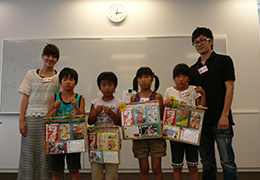

It is important to cultivate sense of well-being among children. Keio University students participate producing workshops to get across the importance of life and health to elementary school students.
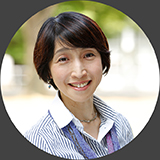
Miki Akiyama
Miki Akiyama, Ph.D. is an Associate Professor at Faculty of Environment and Information Studies, Keio University. Dr. Akiyama is an active contributor in the areas of health communication and community health research and practices in Japan. She is the founder of “Karada-kan health information station” in Tsuruoka city. She recently published several articles on community intervention of comprehensive palliative care program for cancer patients. She teaches courses on public health practice, epidemiology and research design at Keio SFC and at Keio School of Medicine.
Akiyama started her carrier as a television broadcaster at Sendai Television Inc. She furthered her studies in the Master’s course (MSc. Media and Communication Policy and Regulation) at the London School of Economics and Political Science (LSE), and later completed the doctoral program at the Graduate School of Media and Governance, Keio University. Eventually, she earned two Ph.D. degrees (Media and Governance, and Medicine) in Keio University. She is a certified social worker.
(Japanese Only)http://akiyama-lab.sfc.keio.ac.jp/

2015.Nov ISSUE